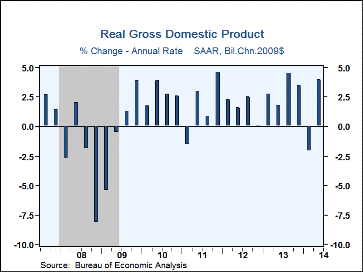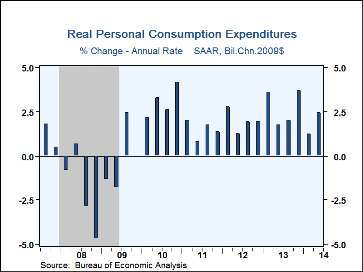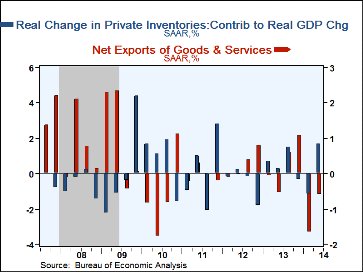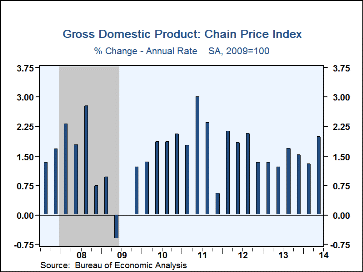 Global| Jul 30 2014
Global| Jul 30 2014U.S. GDP Recovery is Surprisingly Brisk
by:Tom Moeller
|in:Economy in Brief
Summary
The economic recovery returned to a firm footing last quarter. The advance GDP estimate indicated a 4.0% rate of growth during Q2. The gain follows a 2.1% Q1 decline, revised from -2.9% and depressed by weather, inventory & foreign [...]
The economic recovery returned to a firm footing last quarter. The advance GDP estimate indicated a 4.0% rate of growth during Q2. The gain follows a 2.1% Q1 decline, revised from -2.9% and depressed by weather, inventory & foreign trade effects. The gain was the strongest since Q3'13 and outpaced expectations for a 3.0% rise in the Action Economics Forecast Survey. Figures were revised back to 1999.
Consumers resumed spending at a 2.5% rate (2.3% y/y) following a subdued 1.2% rise. The gain was powered by a 14.0% jump (6.9% y/y) in spending on durable goods. Motor vehicles purchases rose 17.5% (7.4% y/y) while furniture spending jumped 13.1% (6.9% y/y). In the nondurable goods sector, apparel spending rose 6.9% (0.4% y/y) as it recovered from a Q1 decline. Services spending nudged 0.7% higher (1.7% y/y), the rise depressed by a sharp drop in spending on housing & utilities.
Business investment growth also improved to a 5.5% rate (5.7% y/y) after a modest 1.6% rise. Spending on equipment gained 7.0% (6.1% y/y) driven by a 21.4% surge (2.9% y/y) in information processing, while structures investment rose 5.3% (7.9% y/y). Residential investment recovered 7.5% (0.9% y/y) after a 5.3% decline. Government spending increased at a 1.6% rate (-0.7% y/y), the first positive result since two 0.2% upticks during the middle of last year. The latest rise was driven by a 3.1% gain (0.9% y/y) in state & local spending. Federal government outlays fell 0.7% (-3.2% y/y) due to a 3.7% drop (-2.6% y/y) in nondefense spending. Defense outlays rose 1.0% (-3.6% y/y) following two quarters of sharp decline.
A rebound in inventory investment added 1.7 percentage points to GDP growth following subtractions during the prior two quarters. Deterioration in the foreign trade deficit subtracted another 0.6 percentage points from growth. A 9.5% gain (3.5% y/y) in exports only recovered a Q1 decline and was outpaced by an 11.7% rise (3.9% y/y) in imports.
Price inflation picked up steam, reflected by a 2.0% rise (1.6% y/y) in the GDP price index, the strongest gain in roughly two years. The PCE price index rose 2.3% (1.6% y/y), the strongest gain in three years. Prices excluding food & energy rose a heightened 2.0% (1.5% y/y). The capital goods price index rose at a reduced 1.2% rate (1.3% y/y).
The latest GDP figures can be found in Haver's USECON and USNA databases; USNA contains basically all of the Bureau of Economic Analysis' detail in the national accounts, including the integrated economic accounts and the recently added GDP data for U.S. Territories. The Action Economics consensus estimates can be found in AS1REPNA.
| Chained 2009 $, %, AR | Q2'14 (Advance Estimate) | Q1'14 | Q4'13 | Q2 Y/Y | 2013 | 2012 | 2011 |
|---|---|---|---|---|---|---|---|
| Gross Domestic Product | 4.0 | -2.1 | 3.5 | 2.4 | 2.2 | 2.3 | 1.6 |
| Inventory Effect | 1.7 | -1.2 | -0.3 | 0.2 | 0.0 | 0.1 | -0.1 |
| Final Sales | 2.3 | -1.0 | 3.9 | 2.0 | 2.2 | 2.2 | 1.7 |
| Foreign Trade Effect | -0.6 | -1.7 | 1.1 | -0.1 | 0.3 | 0.1 | 0.0 |
| Domestic Final Sales | 2.8 | 0.7 | 2.7 | 2.1 | 1.9 | 2.1 | 1.7 |
| Demand Components | |||||||
| Personal Consumption Expenditures | 2.5 | 1.2 | 3.7 | 2.3 | 2.4 | 1.8 | 2.3 |
| Business Fixed Investment | 5.5 | 1.6 | 10.4 | 5.7 | 3.0 | 7.2 | 7.7 |
| Residential Investment | 7.5 | -5.3 | -8.5 | 0.9 | 11.9 | 13.5 | 0.5 |
| Government Spending | 1.6 | -0.8 | -3.8 | -0.7 | -2.0 | -1.4 | -3.0 |
| Chain-Type Price Index | |||||||
| GDP | 2.0 | 1.3 | 1.5 | 1.6 | 1.5 | 1.8 | 2.1 |
| Personal Consumption Expenditures | 2.3 | 1.4 | 1.0 | 1.6 | 1.2 | 1.8 | 2.5 |
| Less Food/Energy | 2.0 | 1.2 | 1.3 | 1.5 | 1.3 | 1.8 | 1.5 |
Tom Moeller
AuthorMore in Author Profile »Prior to joining Haver Analytics in 2000, Mr. Moeller worked as the Economist at Chancellor Capital Management from 1985 to 1999. There, he developed comprehensive economic forecasts and interpreted economic data for equity and fixed income portfolio managers. Also at Chancellor, Mr. Moeller worked as an equity analyst and was responsible for researching and rating companies in the economically sensitive automobile and housing industries for investment in Chancellor’s equity portfolio. Prior to joining Chancellor, Mr. Moeller was an Economist at Citibank from 1979 to 1984. He also analyzed pricing behavior in the metals industry for the Council on Wage and Price Stability in Washington, D.C. In 1999, Mr. Moeller received the award for most accurate forecast from the Forecasters' Club of New York. From 1990 to 1992 he was President of the New York Association for Business Economists. Mr. Moeller earned an M.B.A. in Finance from Fordham University, where he graduated in 1987. He holds a Bachelor of Arts in Economics from George Washington University.












